Critique Submissions‚ September, 2000
This page contains submissions made during September, 2000 from photographers who wished to have their photographs reviewed by the publisher of this site,Michael Reichmann.For additional details see theCritique / Contestpage.
The September winner of a complimentary 1-year subscription to theLuminous Landscape Video JournalwasPeter Jarver.
Peter Jarver
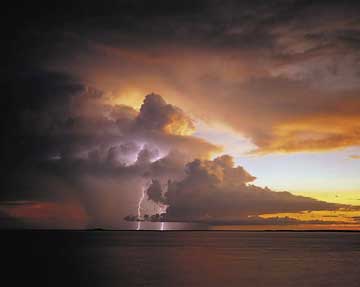
Peter Jarver
Email:info@peterjarver.com
I have been photographing for about twenty years, and in the past have used mainly the 4×5 format, but more recently am shooting on the Mamiya 7 and the Linhof Technorama. I make my living from publishing, a small amount of commercial photography, stock library and more recently from our Gallery which is located in Cairns, Australia.
Michael’s Critique
Two submissions with lightning in one afternoon. Remarkable. As is this photograph. Everything works right‚ the subject is dramatic, the framing perfect and of course capturing the lightning stroke a wonderful bit of luck, or more likely perseverance. Needless to say, I’m impressed and have nothing but admiration for this photograph.
You can add your own comments on Peter’s photograph on theCritiquesection of ourDiscussion Forum.
Thomas W. Earle
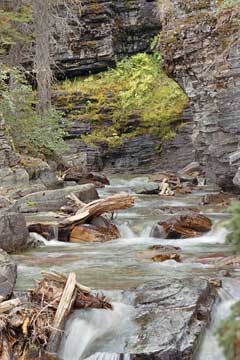
Thomas W. EarlePendleton, Oregon (USA)Email:twade@bmi.net
Film: Fuji Velvia @ ASA 40Exposure: 1/15 @ f/22Camera: Pentax 67Lens: 55 mmDetails: Photo shot in Glacier National Park, MT during the Month of June 1999. The time was about two hours after sunrise. Michael’s Critique
I’ve looked long and hard at this image and I’m not sure how it could be improved compositionally‚ though it needs to be. It fails to move me, though I love the look of the locale. Glacier NP is one of the Parks that I’ve yet to visit.
It’s a shot that I would probably have taken myself, but then put aside because it didn’t quite work. That’s one of the challenges of doing any type of photography with passion. You have to be willing to put away the "almosts", learn from them and try again.
You can add your own comments on Thomas’ photograph on theCritiquesection of ourDiscussion Forum.
Paulo Bizarro
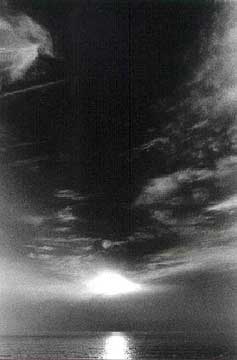
I had spent the best part of the afternoon just observing shore birds in the cliffs, and the only photo gear I had carried along consisted in my 1n and 24 T/S lens. I had planned to photograph some rock formations in B&W, but the trail down the cliff turned out to be too dangerous due to recent heavy rainfalls. So I watched the birds and waited for sunset.
The shot was made with Tri-X film rated at 400 ISO, the lens was set at f/8. I spot metered the sky. I waited for the clouds in the sky to give me a more dramatic perspective, together with the sun’s trail in the water. Location is Cape Sardão, SW Portugal.
Michael’s Critique
Two months ago I had criticized Paulo’sprevious contributionsas being too "safe and predictable. This month’s contribution is spot-on. It’s dramatic, well visualized and compelling. The high contrast grainy style is completely in keeping with the ominous look of the sky and the dark central area contrasted with the burned-out sun and its reflection keep my eye moving around the image, searching but finding nowhere to rest. This builds tension, which is part of why the photograph works so well.
You can add your own comments on Paulo’s photograph on theCritiquesection of ourDiscussion Forum.
Collin Orthner

(I have place a frame around the photograph so that its borders are visible against the black background of this web page. MR)
Collin Orthner
Red Deer, Alberta,Canada
corthner@home.com
This is the Alberta badlands at Drumheller under siege of a massive summer storm. This image was made by combining 3 separate images in Photoshop. The lightning is a real strike and not added. A very tough thing to capture during daylight hours and requires a good amount of luck.
Nikon F3 and 24/2.8 on Fujicolour 100
Approx. 1/30 sec @ f/5.6
Michael’s Critique
This is a stunningly beautiful photograph. I’m partial to wide-aspect ratio (panoramic) images and this one just draws me in. I can almost smell the ozone. Sometimes composites that are this wide don’t work well because the perspective is strained beyond what people are used to seeing. In this case I feel that it works, and works well, possibly because of the large black cloud area in the center that forces the eye to shift from one side to the other. Quite an image!
You can add your own comments on Collin’s photograph on theCritiquesection of ourDiscussion Forum.
Ian Russell
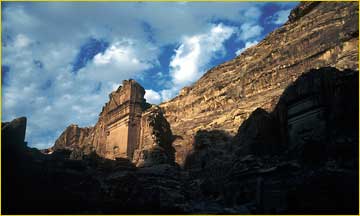
(I have place a frame around the photograph so that its borders are visible against the black background of this web page. MR)
Ian Russell
Amman, Jordan
This photo was taken on a bright mid-winter day at the ancient ruins of Petrain Jordan. The stone mountain seems to be gradually overgrowing this huge andmysterious sculpture.
Technical Details: Leica M6, 90mm Elmarit (I think): Fuji 100 ISO Color Negfilm; scanned on Nikon LS-2000; Photoshop 5.5
Michael’s Critique
Photographs of rock formations taken under mid-day light rarely work. This one partially succeeds because of the strong cloud pattern and the stark foreground silhouette. I’m suggesting the cropping you see below though. It accentuates the left-to-right sweep and makes the rock and sky more dominant components of the composition. The shadow area is important but it shouldn’t predominate.
Finally, if the shot had been taken with a longer lens the ruins should been more visible and created a stronger point of interest.
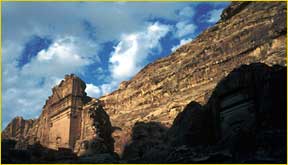
You can add your own comments on Ian’s photograph on theCritiquesection of ourDiscussion Forum.
Dennis J. Begnoche Jr.
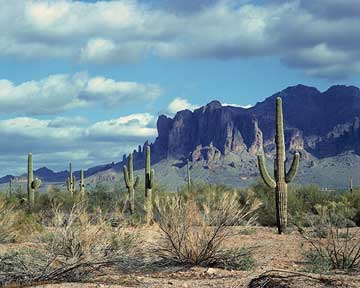
Dennis J. Begnoche Jr.
Palm Springs California
Photo taken taken east of Phoenix, Arizona with Pentax 6×7 Camera using Pentax 165 LS lens. Taken at f32 using Kodak 100 ASA slide film
Michael’s Critique
Regrettably, like all too many of the submissions received this photograph is little more than a documentary record of a time and place. I like what I see in terms of the subject matter, but the photographer has not told me anything, or presented anything to make we want to take asecondlook.
You can add your own comments on Dennis’ photograph on theCritiquesection of ourDiscussion Forum.
Robert Heron
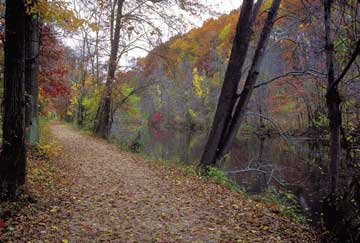
Robert Heron
rbheron@earthlink.net
Denver, CO
This image was taken where the Delaware & Raritan Canal and the Millstone River coincide near Kingston, NJ. I felt humbled by the beautiful soft light, the mild temperature, and the smell of fallen leaves. There was a stillness and a quiet that permeated the whole area. I used a Nikon FM2 with a 24mm lens. The film was Fuji Velvia shot at f16 at 1/60th sec.
Michael’s Critique
I want to like this shot. At the level of personal experience it works well. I love the location and can imagine myself walking along this path enjoying the soft overcast late-fall day.
Unfortunately as a photograph it fails. There’s too much going. The trees on the right are distracting. The path should lead the eye somewhere, but it doesn’t. I feel that the hillside on the other side of the river has the most promise, but it’s obscured by the foreground trees. Too bad. I want it to work, but it doesn’t.
You can add your own comments on Robert’s photograph on theCritiquesection of ourDiscussion Forum.
Jay Peters
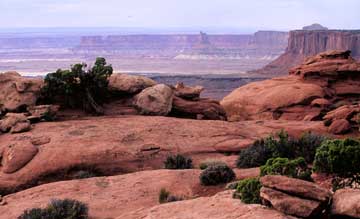
Name: Jay Peters
City: Downingtown PA USA
e-mail: jpeters@ingfunds.com
Camera: Canon EOS-1N
Lens: Canon 17-35
Film: Fuji Velvia
Location: Dead Horse State Park, Utah
The day was overcast with intermittent showers.
Michael’s Critique
I’m including this photograph as an example of the type of image that I will no longer be accepting in this section. I am critical of it because it has nothing in particular to say. It records the scene, but that’s it. Being there with a camera isn’t enough. When doing landscape photography one needs to find an aspect of the locale, the weather or the light that provides a perspective that is fresh, unique or provocative. This photograph unfortunately has none of these ingredients.
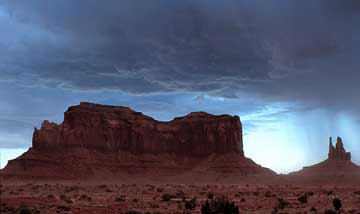
Because I was harsh in my criticism of Jay’s first photograph above I am breaking my one-picture-per-month rule and accepting this one as well. Unlike Jay’s first entry this one has something to say. The atmospherics and light are fascinating and the buttes provide excellent foreground interest.
This is a good point to remind ourselves that landscape photography is 75% about light and 25% about subject matter. You need both, but without interesting light the subject has to carry an awful lot of weight. In Jay’s first image I believe that it failed, while in the one above it creates drama and interest.
You can add your own comments on Jay’s photographs on theCritiquesection of ourDiscussion Forum.
Jeff Alu
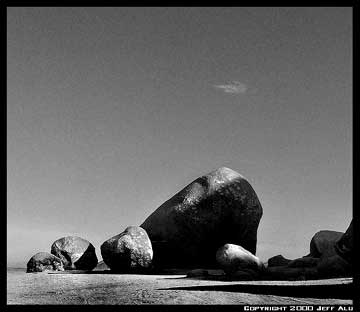
Jeff Alu
Irvine CA
animalu@animalu.com
This was taken using a Kodak DC-280 Digital Camera, + a circular polarizer.
It was taken at Giant Rock, near Yucca Valley, CA. The large boulder in the pic is the largest free-standing rock in the world (or so I’ve heard). At this angle I found that with no people, cars, etc. the scale was totally obscured. There weren’t many people here on this day, and I could hear explosions and saw a few distant mushroom clouds at the nearby naval weapons test center. Made for a surreal state of mind!
Michael’s Critique
What I find most interesting about this photograph is that it was taken with an inexpensive digital camera. It shows that with good technique (and most importantly a good eye) quality images can be taken regardless.
Of course what makes the image for me is the one lone wispy cloud. In this case much better than a more complex and dramatic sky because of the way that it compliments the starkness of the rock field.
You can add your own comments on Jeff’s photograph on theCritiquesection of ourDiscussion Forum.
Gene Zonis
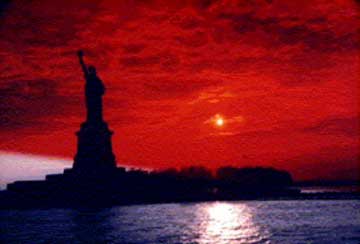

Gene Zonis
Freehold, N.J.
gz927@erols.com
Shot was made from sightseeing boat in NY Harbor.
Minolta 7000i, Tamron 28-200 lens with Hoya red filter.
Camera on program. Kodak gold 200.
Michael’s Critique
This photograph annoys me. It could have been really good. But, my first impulse was to simply reject it. Why? For one thing because the horizon isn’t level. As you can see from the smaller version alongside it, having a level horizon allows you to concentrate on the image rather than be distracted by the tilt. Any photo editor will instantly reject even an otherwise stunning photograph if its this badly tilted.
Next, the photograph is out of focus. Is this because of the use of the red filter? I wonder.
Nevertheless, I really like the image, notwithstanding all of its shortcomings. The contrast of the intense red clouds and blue water combined with the instantly recognizable silhouette of the Statue of Liberty allows this clichéd subject to be seen with a fresh perspective.
You can add your own comments on Gene’s photograph on theCritiquesection of ourDiscussion Forum.
Sherry Bradley
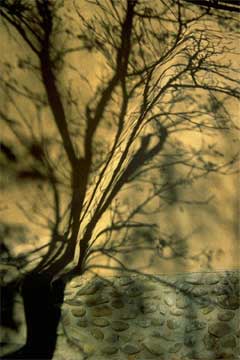
Sherry Bradley
Denver,CO
sabradley@earthlink.net
Shadows of trees and plants that change according to contours of objects they touch have always been my fascination. Observing trees while still leafless in Spring, as this image shows, interests me more than trees in full regalia. I shot this in May 2000 of El Santuario de Chimayo’s shadow-covered east side. Built in the 1700s for the Spanish, Chimayo ("flaking stone") is the Tewa name describing the rock outcroppings of the Chimayo Valley.
I used a Nikon EM90 with f2.8 Albinar lens set at f16, 1/125, and Velvia film.
Michael’s Critique
Sherry’s photograph is a poem written with light. I love the soft colours and the mysterious branch forms. My only small suggestion would be to crop the very top of the frame where a small piece of what appears to be window frame detracts from the simplicity of the composition. A very lovely image indeed.
You can add your own comments on Sherry’s photograph on theCritiquesection of ourDiscussion Forum.
Mark Gourley
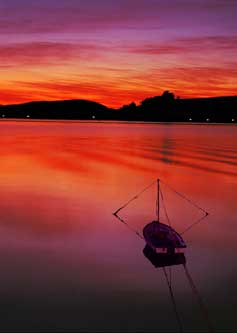
Mark Gourley
Dunedin
New Zealand
imageart@xtra.co.nz
This is a shot of a very early sunrise (slightly before the sun came up). It was about 5am in the morning during the winter months in my country. It is of the harbour channel where ships come down to dock at the wharf, and being a channel you have the choice of driving down either side, hence the car headlights of travellers on there way to work.
Michael’s Critique
This type of pre-dawn light can be some of the loveliest of the day. The stillness of the water at this time of day also contributes to the sense of serenity conveyed. A very pleasing image indeed though the horizon being slightly off-level is disconcerting. Since it is clearly a tripod-based shot there really is no excuse for this.
You can add your own comments on Mark’s photograph on theCritiquesection of ourDiscussion Forum.
Michael Barnett
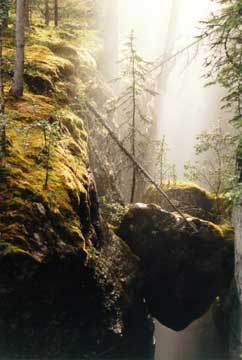
Name: Michael Barnett
City: Melbourne
Country: Australia
Email: mikebear@netspace.net.au
Camera: Nikon F90
Lens: Nikkor 70-210 AF
Film: Fuji 800 ASA negative film
This photograph was taken at Maligne Canyon in the Jasper National Park, Alberta, Canada on August 24 1997. It was taken some time mid-morning at full zoom, probably on automatic exposure and definitely without a tripod. I don’t recall if I supported the camera on the bridge I was standing on. It is impossible to comprehend the scale of the scene from this picture without seeing the wider landscape. The tree/rock setting was very obscure and easily overlooked.
Michael’s Critique
Jasper is one of the places on mymust visitlist and Michael’s photograph has made me want to go there more than ever. This is an exceptionally beautiful image that benefits immensely from the softness of the light. I can’t find anything to fault and much to admire.
You can add your own comments on Michael’s photograph on theCritiquesection of ourDiscussion Forum.
Dai Rhys
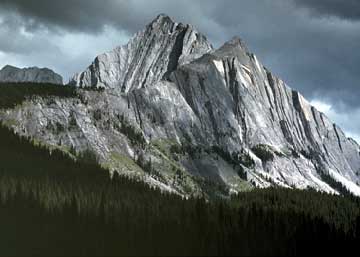
Name: Dai Rhys
Address: Bragg Creek, Alberta
E-Mail: dave@icalgary.com
Description: A 25-year-old Kodachrome I always liked but never printed. An Imacon scan surprised the heck out me and has me rummaging through the files. Probably shot with an Olympus OM-1 and standard lens or possibly the 75-150 zoom. Sawback range in Banff National Park. Sedimentary rock often resists the play of light (no granite hereabouts), but when the layers are tipped vertically as they are here (thus the Sawback name), and the conditions are right, a ‘Yosemite’ look and feel is perhaps possible.
Michael’s Critique
Two images in a row from the Canadian Rockies. Quite a coincidence. I wasn’t surprised to learn that this image is from a Kodachrome. It has that "gray-blue" look that we don’t see very much these days.
I find it to be a well realized photograph. The almost silhouetted foreground trees and the dramatic dark clouds create an appropriate frame for the ragged peaks.
I’d like to have seen a bit more of the rock face to the left and right — they appear somewhat too abruptly cut off, but otherwise this is a very satisfying photograph.
You can add your own comments on Dia’s photograph on theCritiquesection of ourDiscussion Forum.
Patrick Paulin
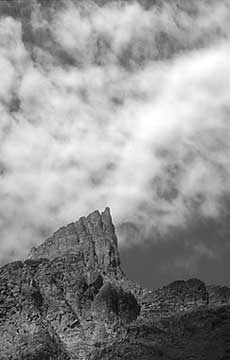
Patrick Paulin
Madison, Wisconsin USA
ppaulin@archeologic.com
www.archeologic.com
Pentax K1000 with 50mm lense on Fuji Provia 100F
This is a shot of Grinnell Point in the Many Glaciers area of Glacier National Park. I liked the simple composition of the shot and the way the light plays along the rock. The image was converted to B&W using the Photoshop Channel Mixer.
Michael’s Critique
This month’s submissions have seen a number of monochrome images of rock formations and sky. Patrick’s is well seen and executed. I particularly like the vertical format with a preponderance of sky. It makes the composition appear unbalanced at first, but after some moments viewing becomes appropriate. By either luck or intent the pinnacle of the rock points straight into the white cloud, almost creating the impression of a lightning bolt.
Nicely done.
You can add your own comments on Patrick’s photograph on theCritiquesection of ourDiscussion Forum.
Attila Kirjak
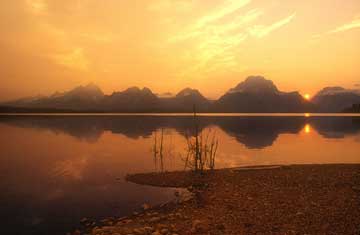
Attila Kirjak, New York
Michael’s Critique
Attila has captured a striking photograph. Technically well done and well visualized. I’m particularly taken with the timing, which has the setting sun sitting just in the notch of the mountains. The left-to-right "S" curve of the shoreline leads the eye to the sun (the focal point of the composition) and the mountains.
My only suggestion would be to crop the bottom of the frame a bit, maybe just below the first curve on the sand. This would lend the image a slightly panoramic perspective and simplify the composition a bit.
You can add your own comments on Attila’s photograph on theCritiquesection of ourDiscussion Forum.
Chris VenHaus
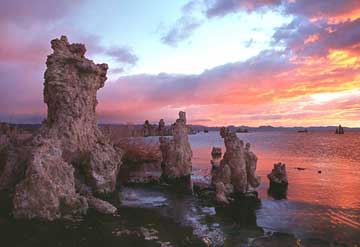
Chris VenHaus
Waukesha WI
drmr@execpc.com
Canon A2E
Canon 35mm f2.0 lens
Fuji Provia F
Bogen Tripod
This was taken over Labor Day weekend shortly after Sunrise. The warm light on the Tufas gave them a certain glow that was best captured in the slide, but mostly lost in the scan (Minolta Scan Speed). I was lucky with the light that morning as I had just enough on the Tufas to show some detail, yet I had wonderful color in the clouds/sky to add some drama.
Michael’s Critique
Mono Lake in California always fascinates. The light in the high Sierra is always breathtaking at both dawn and sunset, and Chris has done a fine job of integrating the dramatic shapes of the foreground formations with the intensity of the sky. An impressive image.
You can add your own comments on Chris’s photograph on theCritiquesection of ourDiscussion Forum.
Ed Leys
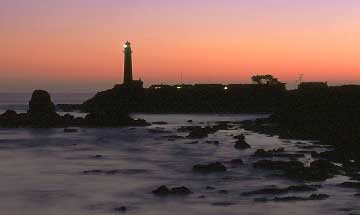
Ed Leys
MilpitasCalifornia
eleys@meer.net
Post sunset at Pigeon Point, California. More seascape than landscape. The hand of man shows.
Data: Nikon FA; Nikon 70-300mm zoom at 70mm; Provia 100F exposed at EI 200, push processed one stop; f/11, exposure duration camera determined, but it seemed to be well in excess of 30 seconds. The beacon swung into the frame at least twice. The sea also resisted staying still.
Michael’s Critique
The softness and mystery of this photograph are appealing. The long exposure has made the ocean turn into a foggy mist and the soft pink sky is in perfect counterpoint to the gray/blue of the water. It would have been nice to see the end of the jetty and the rocks. As is, the left side ends somewhat abruptly.
You can add your own comments on Ed’s photograph on theCritiquesection of ourDiscussion Forum.
Rick Popham
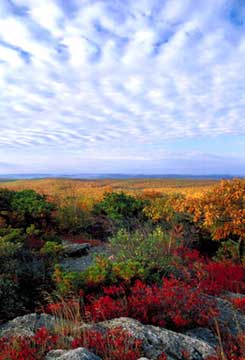
Rick Popham
Torrington, CT (USA)
EMail: rickio@esslink.com
Film: Fuji Velvia
Exposure: Unrecorded
Camera: Nikon F3
Lens: Probably 24mm f 2.8 Nikkor
This is a view from the Appalachian Trail descending south from Bear Mountain in Salisbury, CT. It was a beautiful morning in early October, about an hour after sunrise.
Michael’s Critique
The last week has seen a succession of very high quality submissions. This latest one has great appeal even though it breaks a cardinal rule of composition with the horizon line through the middle of the composition. The colour transition from red to-orange to-blue to-white creates a truly eye catching photograph.
You can add your own comments on Rick’s photograph on theCritiquesection of ourDiscussion Forum.
Pete Dickson
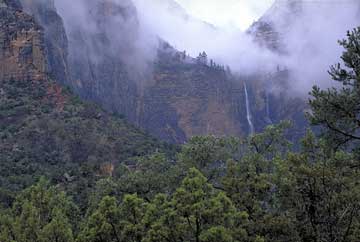
Pete Dickson
Cincinnati, OH/USA
dickson.pn@pg.com
Film: Probably Elitechrome 100
Camera: Nikon F4
Lens: Nikkor 50-135 f/8 or f/11
Tripod of course
Zion National Park in the Rain – March 1998
I was a little overwhelmed by the green after coming down from the Mt.Carmel entrance to the park where I saw little but fog and patchy snow. I trudged around the valley in the rain and got soaked to the bone and very cold. It was good to be there. Every cloud has silver lining.
Michael’s Critique
Often when we are in spectacular locales we project our sense of awe, wonderment or esthetic pleasure onto the photographs that we take, and are consequently unable to be objective about them afterward. I think that this could be the case in Pete’s photograph above. I’ve been inZion National Parkwhen the waterfalls are flowing heavily after a rain and it’s a most beautiful thing to behold. But, capturing it effectively on film is another matter.
Pete’s image doesn’t do much more than create a record of what was there at the time. A attractive place to be for sure, but for a photograph to "work" it has to do more. Possibly in this case a long-lens view that isolated just the clouds, cliff face and waterfall would have made for a more compelling composition.
You can add your own comments on Pete’s photograph on theCritiquesection of ourDiscussion Forum.
Bernhard Gustafsson
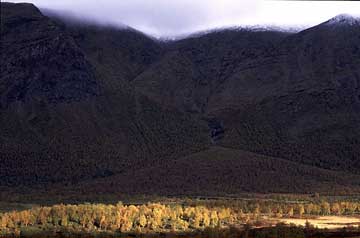
Name: Bernhard Gustafsson
City: Göteborg, Sweden
Email: begu@tfd.chalmers.se
Camera: Nikon F90x
Lens: AF50/1.4D
Film: Provia 100F
Date: 12 September, 2000
Location: Tarradalen (The Tarra valley), Kvikkjokk, Lappland, Sweden
Comments:
This was one of the more beautiful views recent journey to the northern parts of Sweden. It was an overcast day but suddenly the sun broke through and shone on the red/yellow birches down in the Tarra valley. Unfortunately the film and scanner could not capture the dynamic range of the scene (low level of detail in the mountain side).
Michael’s Critique
Luck has been described as "Preparedness in the face of opportunity". That being the case, Bernhard has created a very lucky photograph. Being at the right location at the right time with the right equipment is what makes landscape photography a challenge, a frustration and sometimes a joy.
Though the composition is unusual, with areas of interest at the extreme top and bottom of the frame, the mystery created by the dark but still visible center makes this a compelling photograph.
You can add your own comments on Bernhard’s photograph on theCritiquesection of ourDiscussion Forum.
Bruce Scorsone
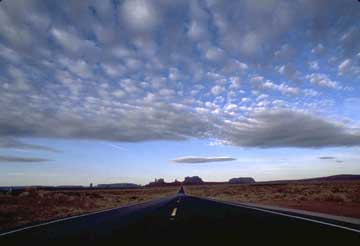
Bruce Scorsone
1466 Lathrup Saginaw MI USA. 48603
bscorsone@aol.com
This photograph was taken about 13 miles north of Monument Valley. I was leaving the valley at the time, and saw this scene in my rear view mirror. I stood in the middle of the road, and placed the camera, on a tripod, close to the pavement. Used a Nikon 8008S w/ 20 mm Nikon lens, Fuji Velvia.
Michael’s Critique
I smiled when I first saw this photograph because I, like most photographers who’ve visitedMonument Valley, have taken this same shot. (Clickhereto see mine.) I very much like what Bruce has done with it. The sky is wonderful and the whole image has a very strong graphic feel.
But!!!Once again we see here a photograph whose purpose is damaged by not being level. It’s off by at least 1 degree. As I’ve said before, this is a cardinal sin in my book as it completely distracts from any other merits that a photograph may have. Common folks. If you can’t shoot straight at least straighten it when printing!
You can add your own comments on Bruce’s photograph on theCritiquesection of ourDiscussion Forum.
Tony Makepeace

Tony Makepeace
Toronto Ontario M5V 2Y8
http://www.tonymakepeace.net
Michael’s Critique
This triptych knocked me back on my heals when it arrived. It is so counter to the general run of submissions received that it, plus a visit to Tony’s web site, has caused me to give some fresh thought to how I approach my own work. Needless to say it exhibits an artist’s sensibilities and is a challenging photograph.
Tony’sweb siteis well worth a visit. You’ll find his work stimulating and of the highest caliber.
You can add your own comments on Tony’s photograph on theCritiquesection of ourDiscussion Forum.
Ovidiu Moise

Ovidiu Moise.
Houston, TX
Ovidiu.L.Moise@uth.tmc.edu
www.photo.net/users/ovidiu moise
Nikon F601, 35-70 @ 50mm, f8, 1/60, Fujichrome Velvia
The story says that people were changed into stones as punishment for their behavior. This one seems to meditate about life while looking at the dying tree. I walked around this point for a few hours, shooting from different positions, before getting the right clouds position.
Michael’s Critique
This is a striking photograph, but I can’t help thinking that it would have been much more dramatic if taken either earlier or later in the day. Though the cloud formations help a great deal they can’t mask the fact that the flat mid-day sun plays too strong a role.
I also would have zoomed in a bit more or cropped the image more tightly to accentuate the horizontal sweep of the crest and draw more attention to the face and tree. All-in-all this image has great potential but just misses.
You can add your own comments on Ovidiu’s photograph on theCritiquesection of ourDiscussion Forum.
All Photographs on This Page are the Copyright of Their Respective Photographers
All Rights are Reserved
You May Also Enjoy...
Guide to Image Quality
NEW Maximize the Image Quality of every shot you take! This download video tutorial identifies the key factors that lead to exceptional in-camera image quality
